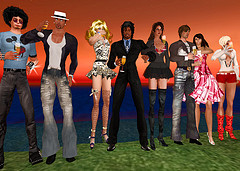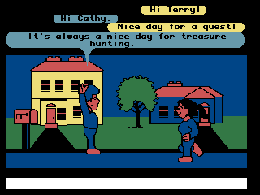
From time to time, I’ll give an overview of one broad MediaShift topic, annotated with online resources and plenty of tips. The idea is to help you understand the topic, learn the jargon, and take action. I’ve already covered blogs, social networking, widgets and various other topics. This week I’ll look at the growing phenomenon of virtual worlds.
Background and History
Virtual worlds are online three-dimensional spaces where you can interact with other people, collect items and build structures, and communicate via a virtual representative of yourself called an avatar. These worlds have been influenced by various science fiction writers such as William Gibson and Neal Stephenson, along with the movie, “The Matrix.”
Virtual worlds differ from massive multiplayer online games (MMOGs) because they don’t offer battles against monsters or have an overriding mission for players. For example, a resident of the virtual world Second Life might spend time in that space accumulating virtual land, rather than striving to complete quests or conquer levels as one would in many popular MMOGs such as World of Warcraft.
The origin of virtual worlds goes back to early games such as Maze War, which was developed in the early ’70s at NASA. The game included eyeballs as avatars, there were maps showing the levels, and it was one of the first games played on networked computers, and eventually over a precursor to the Internet.

In 1986, LucasFilm Games developed Habitat, a more two-dimensional environment that included humanoid avatars, and people could access the game through online service Quantum Link on their Commodore 64 computers. Developers Chip Morningstar and Randy Farmer, who maintain a blog about their experience with Habitat, say they let Habitat residents generally set their own rules governing the world — as long as they couldn’t hack into the system. In a research paper about their lessons from Habitat, the developers wrote:
At the core of our vision is the idea that cyberspace is necessarily a multiple-participant environment. It seems to us that the things that are important to the inhabitants of such an environment are the capabilities available to them, the characteristics of the other people they encounter there, and the ways these various participants can affect one another. Beyond a foundation set of communications capabilities, the details of the technology used to present this environment to its participants, while sexy and interesting, are of relatively peripheral concern.
With the rise of the web in the mid-‘90s, virtual worlds started booming, with many startups hoping that these 3D views would become the standard way to browse the web. The Active Worlds platform allowed people to join for free or pay a monthly fee for premium features. The Palace was a more chat-oriented world that became popular in entertainment circles, with the band Korn eventually opening its own themed Palace. Most early virtual worlds faded because the hardware and bandwidth requirements were too stringent, and they never established hardcore user bases as dot-com funding dried up at the turn of the millennium.
The Rise (and Hype) of Second Life
While other worlds were withering, Linden Labs was developing a new world called Second Life, first launched in 2003. It languished for a few years until 2006, when Second Life grabbed the attention of the media and marketers who saw it as a new way of communicating and selling online. BusinessWeek ran a cover story called My Virtual Life, breathlessly explaining that “big advertisers are taking notice.” And Wired Magazine ran a special travel guide to Second Life, while Reuters assigned a full-time reporter, dubbed “Adam Reuters,” to cover news in the world (now there are two).

In Second Life, you can create your own objects and buildings in the world, and you own the intellectual property of what you build Plus, “Linden dollars” are a currency you can trade with real dollars; real-world businesses sell customized stores, avatar wear and just about any kind of “bling” you could want in the virtual world. Universities offer distance learning courses through Second Life, and bands play live shows and chat with fans in special in-world venues. Linden says it has registered nearly 10 million avatars for Second Life.
The buzz around Second Life led many people to explore virtual worlds for the first time, but many ended up disappointed. Even though computer hardware and bandwidth have improved since the ’90s virtual worlds, Second Life still requires high-end systems and a lot of practice to master the interface. The number of registered Second Life avatars is misleading: Many people simply try it out and give up, while others have multiple avatars. A more representative number for regular uers is the number who have logged in during the past seven days, which was 338,068 as of October 7.
That lower number also presents a problem for the crush of marketers such as Coca-Cola and Adidas who have set up virtual spaces in Second Life, only to have them largely vacant. After Wired magazine hyped Second Life with its travel guide, the magazine then did an about-face and ran an article titled, How Madison Avenue Is Wasting Millions on a Deserted Second Life. Many marketers spent the money — in the tens of thousands of dollars — to build a virtual island as an experiment but then got little payoff. Residents are dispersed throughout the virtual world so it’s difficult to get their attention en masse, plus there’s a limit to the number of people who can congregate in one place without crashing Linden’s servers.
(For a detailed argument on Wired’s story and the problem of empty spaces in Second Life, check out this blog post by Wired editor Chris Anderson and the ensuing debate in the comments.)
Media’s Love Affair with Virtual Worlds
Despite the problems with Second Life, media companies are still fascinated with virtual worlds. MTV has created a slew of its own virtual worlds based on the content of its original shows such as “Laguna Beach” and “The Real World,” while Nickelodeon has its teen world, Nicktropolis.
Media companies are smarting after letting independent Internet companies such as Google and Facebook get ahead of them with web search and social networking, so they are loathe to fall behind again with virtual worlds. Even if today’s Second Life doesn’t satisfy the mass market, dozens of other virtual worlds will spring up tailored to each personal taste along the Long Tail of niche content online.
Here’s a sampling of recent deals, launches and buyouts in the virtual worlds space:
> CBS will let viewers of its “CSI: New York” TV show go into Second Life using a special, more simple interface to track a mystery. CBS owns a stake of Second Life developer Electric Sheep Co.
> BBC launched its own kids world called “Adventure Rock” which will be free of charge and advertisement-free.

> Turner made a deal with virtual world builder Kaneva to help create worlds based on Turner’s entertainment properties.
> Disney bought kid space Club Penguin in a $700 million deal.
> In 2005, Viacom bought Neopets.com for $160 million, a virtual world for people with Neopets virtual pets.
Terminology
Here is a rundown of basic terms in Second Life and other virtual worlds:
avatar: The digital representation of yourself that travels through virtual worlds and is often customizable.
griefer: Person who plays pranks, attacks people or defaces Second Life.
lag: The problem with online gaming and virtual worlds where the scene takes time to refresh due to bandwidth and technical issues.
region: A 256 meter by 256 meter space within Second Life that marks off territory.
SLURL: A web address that will take you from the web into a Second Life location.
teleport: A quick way to go from one place to another within Second Life without having to fly or travel there manually.
virtual currency: The money used in virtual worlds, sometimes exchangeable for real-world money as with Linden dollars.
[Thanks to the Puritan’s Guide to Second Life’s Must Know Second Life Vocabulary post for many of these terms.]
Resources
To learn more about virtual worlds — or to visit them — check out the following list of worlds as well as blog posts and articles about the phenomenon.
Partial List of Virtual Worlds
HiPiHi [in Chinese]
Blog Posts and Articles
Big Media Gets a Second Life at BusinessWeek
A Brief History of Virtual Worlds at CNET
CNET Interviewer Assaulted by Flying Wang at the Register
History of Virtual Worlds at Avatar Planet
Sex, drugs and virtual worlds at CNNMoney’s Media Biz blog
A Story Too Good to Check at Valleywag
Virtual world entry in Wikipedia
A Virtual World But Real Money by the New York Times
Virtual World Marketing: Lots of Companies, Few Visitors at GigaOm
What do you think about virtual worlds? Should media companies be spending time and money covering in-world happenings? Which virtual worlds do you enjoy? Let us know if we’re missing any vital stories or worlds in our lists above by using the comments below.
Photo of Second Life avatars by Andromega Volare via Flickr.
Additional research for this story was provided by Jennifer Woodard Maderazo.

A nicely done summary of virtual worlds, Mark!
I would mention Habbo, which engages millions of european youth.
I recently wrote about Newt Gingrich’s appearance in Second Life, which might be of interest to some.
There’s a magazine called theKONSTRUKT that covers the sociology of Second Life. A pretty serious publication, and as it looks like those guys have been in Second Life for ages, they seem to know what they are talking about.
Thats for someone interested in a more analytical coverage of what the heck is happening in those worlds.
I think Second Life is a spectacular waste of time.
Hey! This is a great resource for info/background on Virtual Worlds. So, now that they’re moving forward and changing, etc, I recently threw together some terminology/ideas about the divisions within the virtual world.
I’d love to know what you think:
http://izzyneis.wordpress.com/2007/10/04/a-breakdown-of-virtual-worlds-terminology/
Thanks!
izzy
Is the main difference between the virtual worlds you describe and software packages like the Sims that the former are interactive while the latter are not?
@Dixon: Virtual worlds exist on servers and you connect to them by going online, while packaged software games like The Sims are played on your computer. These games, including the Sims, often give you an online gaming option. However Second Life gives you the chance to customize the world with your own home, clothes, items, etc. Virtual worlds usually emphasize social interaction while MMOGs emphasize game play and questing.
A nice overview of virtual worlds.
The amount of activity at the recent Virtual Worlds Conference and Expo shows just how much movement is going on in this space. I think we are looking at the next evolution of the Internet, and organisations that don’t familiarise themselves with this space will be left behind.
You might find this fairly comprehensive list of virtual worlds weve put together of value – http://sleducation.wikispaces.com/virtualworlds.
I am keen to have a go with second life but apparently it is not compatible with windows Vista. A bit of a problem for me.
Thanks for this background.
Carolyn McIntosh
Good summary. Thought you might be interested in information on the anticedent to Whyville.net, actually programmed in Hypercard, and installed in the Downtown Los Angeles Public Library in 1987 — a virtual library that allowed kids to browse (instead of use the catalog) at the same time motivating them to read books in order to follow animals into otherwise unaccessable parts of the virtual space. Wasn’t multiplayer, but was the first educational use of virtual spaces to my knowledge. Whyville.net, which we launched in 1999, was the multiplayer virtual world version of that idea. Here are some references to articles published in the educational research literature (may be the first) about childrens use of the virtual library.
Borgman, Gallagher, A. L., C.L., Krieger, D., and J.M. Bower. 1990 Children�s use of an interactive catalog of science materials. Submitted to: Proceedings of the 53rd American Society for Information Science (ASIS) Annual Meeting, Vol. 27. November 1990.
Borgman, C.L., Krieger, D., Gallagher, A. L., and J.M. Bower. 1990 Children�s use of an interactive science library: Exploratory research. Research Column, Michael Eisenberg, Editor, School Library Media Quarterly winter, 90: 108-112.
Borgman, C.L., Bower, J.M., Auth, M.J., D. Krieger. 1989 From hands-on science to hands-on information retrieval. In Katzer, J. & Newby, G. (eds.), Proceedings of the 52nd American Society for Information Science (ASIS) Annual Meeting, Vol. 26. October 29-November 2, 1989, Washington D.C. Medfor, N. J: Learned Information, 26: 96-103.
Jim Bower
CEO Numedeon Inc
Founders of Whyville.net
I attended the recent Virtual Worlds Conference and Expo. It was…amazing!
I was forced to accept VISTA when buying a new computer, upgrading the memory from what I previously had allowed me to join and become very active in some of the health related, educational platforms and communities in Second Life.
If you are looking for a more wholesome approach to a virtual world where your daughter or niece is actually in a safe and learning environment, Precious Girls Club is a wonderful new virtual world. http://www.preciousgirlsclub.com
Nice article – a good tutorial for newbies to virtual world. You forgot to mention another virtual world platform that was rated 2008 by Comscore as online game with the highest user engagement: Roblox at http://www.roblox.com
hi